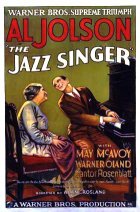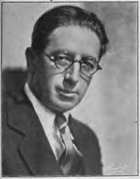
The Jazz Singer Page #7
- UNRATED
- Year:
- 1927
- 88 min
- 1,327 Views
The old man looks at the boy, suddenly awakened from his reverie. His
face sets and his lips compress as he says, very slowly:
TITLE 42:
"I haven't got any boy."Back to scene. Moey looks up at him wonderingly. The old man looks away
and Moey, boylike, is persistent. He tries it again:
TITLE 43:
"But Mike Lefkowitz says your boy is a singerin a theayter way out west -- in Pittsburgh or
Buffalo."
The cantor looks down at Moey as though he just faintly hears him. He
shakes his head, saying to himself, "I have no boy." Then he rises
quickly from the chair and says to the boy:
TITLE 44:
"That is all for today -- come back tomorrow."142.MED. SHOT ROOM
The boy starts out of the room at this, and the cantor sits down again
and is deep in thought as Moey exits.
FADE OUT:
FADE IN:
143.RABINOWITZ LIVING ROOM
Mrs. Rabinowitz is seated in the rocking chair, just opposite and a
short distance from Yudelson. Both have aged considerably. Yudelson is
better dressed and has more of the air of a prosperous citizen. His
beard is neatly trimmed and he wears well-tailored clothes. Mrs.
Rabinowitz's hair is grayer and there are deeper lines in her face. She
is leaning over, listening to Yudelson who has a letter in his hand from
which he is reading.
144.CLOSE SHOT BOTH
Yudelson looks up from the letter as he says: "Y' understand what he
means?" He starts to explain. But Mrs. Rabinowitz stops him and says:
TITLE 45:
"What else does Jakie say in the letter?"Yudelson starts to read again. Sara leans over closer so that she won't
miss a word.
145.CLOSE-UP YUDELSON
He is reading the letter with elaborate gesticulations.
INSERT LETTER:
Omaha, June 4th.
Dear Mama:
I thought you would like to know I am getting
along great in vaudeville, and maybe I will
soon be a headliner, and a wonderful girl
whose name is Mary Dale got me my big chance
out in 'Frisco. Maybe I will be in New York
soon.
Your loving son,
Jakie
P.S. You can write me care State-Lake theater,
Chicago. Remember the name is Jack Robin.
Back to scene. Yudelson looks up as he finishes reading.
146.CLOSE SHOT BOTH
Mrs. Rabinowitz asks Yudelson what Jakie means by headliner. Yudelson
explains, and the old lady is thoughtful a moment.
147.CLOSE-UP MOTHER
She hesitates a moment, then turns to Yudelson and says:
TITLE 46:
"Read it again, what he says about the girl."148.CLOSE SHOT BOTH
Yudelson again reads the passage about Mary Dale. He looks at Mrs.
Rabinowitz as though realizing what she is thinking of. He says: "Nu,
anything else?" Mrs. Rabinowitz hesitates, then says:
TITLE 47:
"Maybe he is fallen in love -- and by her nameshe is a shiksa."
Yudelson thinks a moment, then shrugs his shoulders. He says:
TITLE 48:
"Maybe not -- you know Jennie Levi on thetheayter is Genevieve Leeds."
The old lady is relieved at this solution of her problem. Yudelson hands
her back the letter. She thanks him and he starts to get up.
FADE OUT:
FADE IN:
149.LONG SHOT BACKSTAGE
It is the stage of the State-Lake theater in Chicago, and a matinee
performance is in progress. There is the usual activity among the
stagehands preparatory to changing the set. The act which is now on is a
dancing act, and there is only a fleeting glimpse of the dancers through
the aperture of a narrow entrance. (A novel effect may be had by
shooting through the first entrance so that [there is] a view of part of
the audience as well as some of the dancers who are downstage. The dance
music may be reproduced by the Vitaphone.)
150.MED. SHOT STAGE
Through entrance from another angle there is a more complete view of the
dancers. Mary Dale, the principal of the act, is seen doing a movement
of her dance. (This should be of such grace and technique that would
warrant headline position for Mary.) As the dance comes to a close, a
figure comes into the foreground, and a side view shows that it is Jack
Robin in blackface. He applauds from the wings as Mary finishes.
Apparently he is just ready to go on with his act, or has just finished
and is watching Mary before he takes the make-up off his face.
151.CLOSE-UP JACK
He is applauding vigorously.
TITLE 49:
Orchard Street would have had some difficultyin recognizing Jakie Rabinowitz of Beth-El
choir under the burnt cork of Jack Robin.
Back. He takes a step forward as though to meet the receding dancer as
she bows repeatedly in making her exit.
152.MED. SHOT SAME
Mary almost backs into Jack as she comes off the stage, and he puts out
a hand to catch her arm. The supporting dancers have exited on the other
side. There is just time for an exclamation of surprise from Mary as she
goes on the stage again for another bow. She turns to Jack as she gets
to him and puts a hand on his arm, as he compliments her on her dancing.
She says to Jack with a humorous gleam in her eye:
TITLE 50:
"I don't know what I'd do, Jack, if it wasn'tfor the encouragement you give me."
She laughs as she says this and Jack, realizing that she is kidding him,
says, in a rather embarrassed manner:
TITLE 51:
"Well, you know I'm just crazy about -- your act."It is evident that he loses his nerve as he is about to tell her that it
is she he is crazy about. Mary starts for her dressing room, but is
suddenly awakened to the fact that the audience is still applauding and
she turns quickly to the entrance.
154.MED. SHOT SAME
Mary is out on the stage bowing to the audience again. She bows several
times as she backs into the narrow space again where Jack awaits her.
155.FULL SHOT STAGE
As Jack and Mary walk toward the dressing rooms, several persons on the
stage observe them. Two of the girls in the dancing act who are standing
at a door on the balcony overlooking the stage look at them and turn to
each other.
156.CLOSE-UP GIRLS
One of them, indicating Jack and Mary, says to the other:
TITLE 52:
"He's surely goofy about her."The other one nods and says:
TITLE 53:
"But he ain't got a chance -- no Mammy singerfor Mary."
Back to scene. One opens the door and they go into girls' dressing room,
through the door of which may be seen the girls in various stages of
dishabille.
They are standing in front of the door of the stage dressing room. Jack
starts to leave, but Mary halts him telling him that she has something
to show him. He looks at her wonderingly. She opens the door and darts
into the room, returning immediately with a telegram which she hands
him.
158.CLOSE-UP JACK AND MARY
Translation
Translate and read this script in other languages:
Select another language:
- - Select -
- 简体中文 (Chinese - Simplified)
- 繁體中文 (Chinese - Traditional)
- Español (Spanish)
- Esperanto (Esperanto)
- 日本語 (Japanese)
- Português (Portuguese)
- Deutsch (German)
- العربية (Arabic)
- Français (French)
- Русский (Russian)
- ಕನ್ನಡ (Kannada)
- 한국어 (Korean)
- עברית (Hebrew)
- Gaeilge (Irish)
- Українська (Ukrainian)
- اردو (Urdu)
- Magyar (Hungarian)
- मानक हिन्दी (Hindi)
- Indonesia (Indonesian)
- Italiano (Italian)
- தமிழ் (Tamil)
- Türkçe (Turkish)
- తెలుగు (Telugu)
- ภาษาไทย (Thai)
- Tiếng Việt (Vietnamese)
- Čeština (Czech)
- Polski (Polish)
- Bahasa Indonesia (Indonesian)
- Românește (Romanian)
- Nederlands (Dutch)
- Ελληνικά (Greek)
- Latinum (Latin)
- Svenska (Swedish)
- Dansk (Danish)
- Suomi (Finnish)
- فارسی (Persian)
- ייִדיש (Yiddish)
- հայերեն (Armenian)
- Norsk (Norwegian)
- English (English)
Citation
Use the citation below to add this screenplay to your bibliography:
Style:MLAChicagoAPA
"The Jazz Singer" Scripts.com. STANDS4 LLC, 2025. Web. 23 Feb. 2025. <https://www.scripts.com/script/the_jazz_singer_878>.







Discuss this script with the community:
Report Comment
We're doing our best to make sure our content is useful, accurate and safe.
If by any chance you spot an inappropriate comment while navigating through our website please use this form to let us know, and we'll take care of it shortly.
Attachment
You need to be logged in to favorite.
Log In